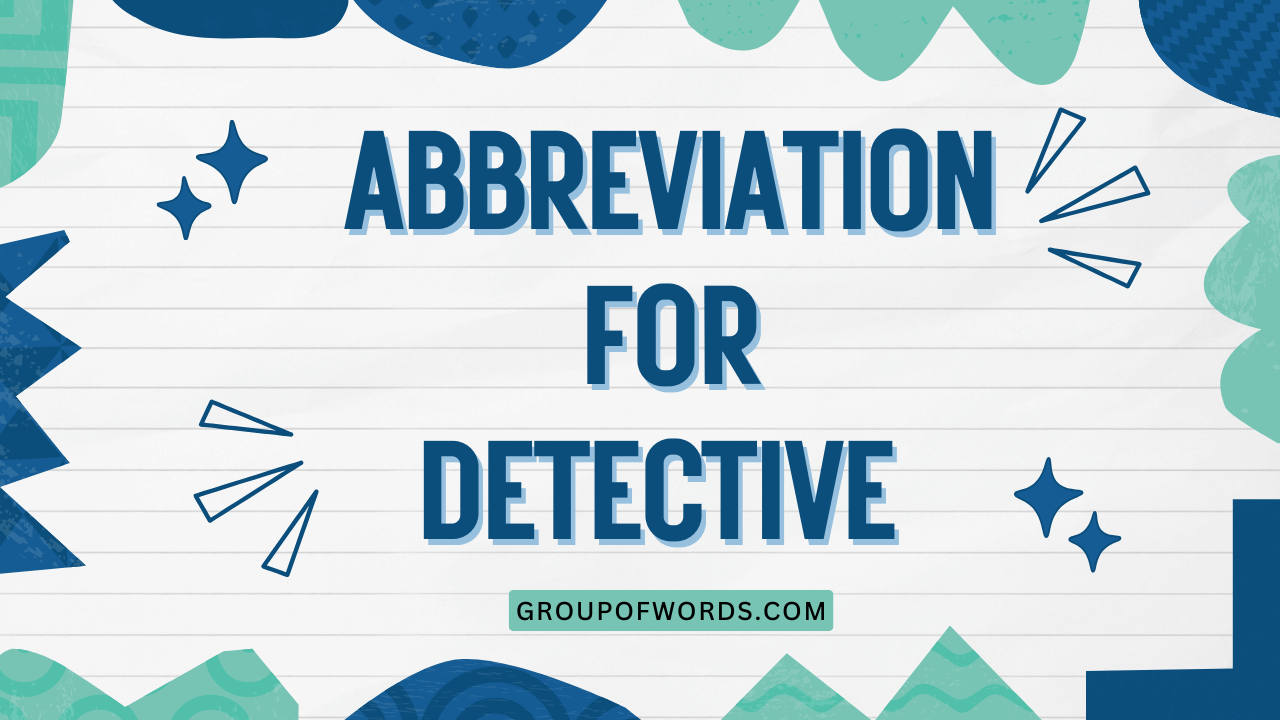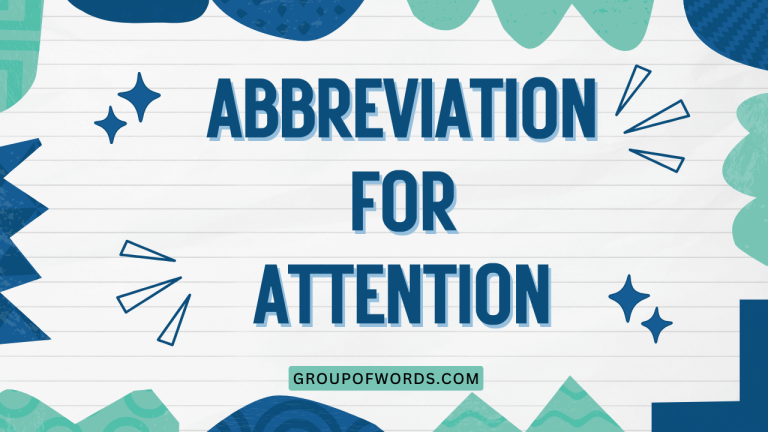Abbreviations for Detective: A Comprehensive Guide
Understanding the correct abbreviations for “detective” and their appropriate usage is crucial for clarity and precision in writing, especially in genres like crime fiction, legal documentation, and journalism. This article delves into the various abbreviations for “detective,” exploring their origins, proper contexts, and common pitfalls to avoid.
Whether you’re a budding writer, a student learning grammar, or simply someone interested in language, this guide will equip you with the knowledge to use these abbreviations effectively and confidently.
Table of Contents
- Introduction
- Definition of Detective and Its Abbreviations
- Structural Breakdown of Abbreviations
- Types and Categories of Detective Abbreviations
- Examples of Detective Abbreviations in Use
- Usage Rules for Detective Abbreviations
- Common Mistakes with Detective Abbreviations
- Practice Exercises
- Advanced Topics: Contextual Variations
- Frequently Asked Questions (FAQ)
- Conclusion
Definition of Detective and Its Abbreviations
A detective is a person, often a member of a police force, whose job is to investigate crimes and gather evidence. The term can also refer to a fictional character who investigates crimes, often in novels or films. The most common abbreviations for “detective” are Det. and Det. These abbreviations are used to save space and time, particularly in formal reports, narratives, and official documents. Understanding when and how to use these abbreviations is essential for maintaining clarity and professionalism in writing.
Classification and Function
Abbreviations are classified as shortened forms of words or phrases. In the case of “Det.” and “Det,” they function as noun abbreviations, standing in for the full noun “detective.” Their primary purpose is to convey the same meaning as the full word while being more concise. The use of a period (.) after “Det” is a matter of style, with some style guides recommending it and others omitting it. The choice often depends on the specific publication or organization’s guidelines.
Contexts of Use
The abbreviations “Det.” and “Det” are frequently used in:
- Police reports: To denote the rank or role of an officer.
- Legal documents: In affidavits, testimonies, and other legal paperwork.
- News articles: When referring to detectives in crime-related stories.
- Fiction writing: In novels, short stories, and screenplays featuring detective characters.
- Informal communication: In emails or memos within law enforcement agencies.
Structural Breakdown of Abbreviations
The structure of the abbreviation “Det.” is straightforward. It consists of the first three letters of the word “detective,” followed by a period.
The abbreviation “Det” omits the period. Both forms are widely recognized and accepted.
The key is to maintain consistency within a single document or piece of writing. It is advisable to choose one form and stick to it throughout.
Here’s a breakdown:
- Det.: First three letters of “detective” + period.
- Det: First three letters of “detective” (no period).
Types and Categories of Detective Abbreviations
Although there is only one primary word being abbreviated, “detective,” the abbreviations themselves can be categorized based on the presence or absence of a period. This seemingly minor difference can affect the formality and style of the writing.
With Period (Det.)
The abbreviation “Det.” includes a period after the “t.” This form is generally considered more formal and traditional. It signals that the word has been shortened.
Many style guides, such as the Chicago Manual of Style, recommend using periods after abbreviations like “Det.” to maintain clarity and consistency.
Without Period (Det)
The abbreviation “Det” omits the period. This form is considered more modern and streamlined.
It is often used in contexts where space is limited or where a more informal tone is acceptable. Some style guides, such as the AP Stylebook, may allow or even prefer omitting periods in certain abbreviations.
Examples of Detective Abbreviations in Use
The following tables provide numerous examples of how the abbreviations “Det.” and “Det” are used in various contexts. These examples will help you understand the nuances of their application and ensure you use them correctly in your own writing.
Examples in Police Reports
This table showcases how “Det.” and “Det” are utilized in police reports, where brevity and accuracy are paramount.
| Example | Context |
|---|---|
| Det. Miller arrived at the scene at 10:00 AM. | Formal report, emphasizing rank. |
| The suspect was questioned by Det Smith. | Informal report, space-saving. |
| Det. Jones collected forensic evidence. | Detailed investigation log. |
| Evidence submitted by Det Brown. | Chain of custody documentation. |
| Det. Garcia interviewed the witness. | Witness statement record. |
| Det Lee is the lead investigator. | Case assignment memo. |
| The report was reviewed by Det. Davis. | Report verification process. |
| Det Wilson secured the perimeter. | Scene security log. |
| Det. Taylor analyzed the surveillance footage. | Evidence analysis report. |
| Det Rodriguez filed the initial report. | Documentation of report origin. |
| The case was assigned to Det. Johnson. | Case assignment record. |
| Det Williams is handling the interrogation. | Interrogation schedule. |
| Det. Anderson processed the crime scene. | Crime scene processing report. |
| Det Moore is in charge of evidence collection. | Evidence handling protocol. |
| Det. Jackson is following up on leads. | Investigation progress report. |
| Det Clark is working with the forensic team. | Collaboration with forensic services. |
| Det. Lewis presented the findings to the DA. | Presentation to the District Attorney. |
| Det Hall is preparing the case for trial. | Trial preparation documentation. |
| Det. Young is coordinating with other agencies. | Inter-agency coordination efforts. |
| Det King is the primary contact for the victim’s family. | Family liaison officer. |
| Det. Wright has been assigned to the cold case unit. | Assignment to cold case division. |
| Det Green is reviewing old case files. | Review of historical case data. |
| Det. Adams is working on the profiling of the suspect. | Suspect profiling analysis. |
| Det Nelson is conducting background checks. | Background investigation procedures. |
| Det. Carter is tracking the suspect’s movements. | Surveillance tracking operations. |
Examples in Legal Documents
This table shows how “Det.” and “Det” are used in legal documents, where precision and adherence to legal standards are crucial.
| Example | Context |
|---|---|
| Affidavit of Det. Evans, dated June 1, 2024. | Legal affidavit referencing the detective. |
| Testimony of Det Roberts regarding the evidence. | Court transcript noting the detective’s testimony. |
| The warrant was obtained by Det. White. | Legal document detailing warrant acquisition. |
| Det Taylor provided crucial information to the court. | Court record mentioning the detective’s contribution. |
| The statement was witnessed by Det. Harris. | Official witnessed statement. |
| Det Martin presented the forensic report. | Presentation of forensic evidence in court. |
| The judge questioned Det. Thompson. | Court proceedings involving the detective. |
| Det Garcia confirmed the suspect’s identity. | Official confirmation of suspect identification. |
| The evidence was authenticated by Det. Wilson. | Authentication of evidence in a legal context. |
| Det Allen filed the search warrant application. | Application for a search warrant. |
| The court acknowledged the expertise of Det. Brown. | Recognition of expertise in court records. |
| Det Davis testified about the chain of custody. | Testimony on the chain of custody of evidence. |
| The defense challenged the findings of Det. Clark. | Legal challenge to the detective’s findings. |
| Det. Lewis swore under oath to the accuracy of the report. | Oath taken by the detective in court. |
| Det Hall was cross-examined by the defense attorney. | Cross-examination during court proceedings. |
| The prosecution called Det. Young as a key witness. | Detective’s role as a key witness. |
| Det King presented the timeline of events to the jury. | Presentation of events to the jury. |
| The judge commended Det. Wright for his thorough investigation. | Commendation by the judge for the investigation. |
| Det Green explained the forensic analysis to the court. | Explanation of forensic analysis in court. |
| Det. Adams provided expert testimony on criminal profiling. | Expert testimony on criminal profiling. |
| Det Nelson discussed the interrogation techniques used. | Discussion of interrogation techniques. |
| Det. Carter elaborated on the surveillance methods employed. | Elaboration on surveillance methods. |
| Det Parker clarified the inconsistencies in the witness statements. | Clarification of witness statement inconsistencies. |
| Det. Baker presented the evidence linking the suspect to the crime. | Presentation of incriminating evidence. |
| Det Ward detailed the steps taken during the investigation. | Detailed explanation of the investigation steps. |
Examples in News Articles
This table provides examples of how “Det.” and “Det” are used in news articles, where clarity and conciseness are essential for conveying information to the public.
| Example | Context |
|---|---|
| Det. Ramirez stated that the investigation is ongoing. | Quoting the detective’s statement to the press. |
| According to Det Chen, the suspect is still at large. | Reporting the detective’s update on the case. |
| Det. Patel is leading the investigation into the robbery. | Identifying the lead investigator in a news report. |
| Det Nguyen declined to comment on the specifics of the case. | Reporting the detective’s refusal to disclose details. |
| The police are seeking information, said Det. Kim. | Encouraging public assistance in the investigation. |
| Det Walker confirmed the victim’s identity. | Verifying information in a news article. |
| The case is being handled by Det. Hill. | Assigning responsibility in a news report. |
| Det Long is appealing to the public for help. | Seeking public assistance in solving the crime. |
| Det. Cook reported a breakthrough in the investigation. | Announcing progress in the case. |
| Det Perry is expected to release further details tomorrow. | Anticipating future updates in the investigation. |
| Det. Butler urged witnesses to come forward. | Encouraging witnesses to provide information. |
| Det Simmons is working closely with the FBI. | Collaboration with federal agencies. |
| The investigation is a top priority for Det. Gray. | Emphasis on the importance of the investigation. |
| Det. Powell is confident that the case will be solved soon. | Expressing confidence in resolving the case. |
| Det Ross is coordinating the search efforts. | Coordination of search operations. |
| Det. Howard is examining the evidence collected at the scene. | Examination of evidence collected from the crime scene. |
| Det Bennett is following several leads in the case. | Pursuing multiple leads in the investigation. |
| Det. Wood is working to identify the suspect. | Efforts to identify the suspect. |
| Det Barnes is interviewing potential witnesses. | Interviewing potential witnesses. |
| Det. Fisher is analyzing the surveillance footage. | Analysis of surveillance footage. |
| Det Spencer is investigating the motive behind the crime. | Investigation of the motive. |
| Det. Morgan is building a profile of the suspect. | Building a suspect profile. |
| Det Reed is seeking the public’s help in identifying the vehicle. | Seeking public assistance in identifying the vehicle. |
| Det. Coleman is reviewing the phone records. | Review of phone records. |
| Det Griffin is working with the forensic team. | Collaboration with the forensic team. |
Usage Rules for Detective Abbreviations
Using “Det.” and “Det” correctly involves understanding stylistic preferences and maintaining consistency. While both forms are acceptable, it’s important to adhere to the guidelines of the specific style guide being followed (e.g., AP, Chicago, MLA).
Here are some general rules:
- Consistency: Choose either “Det.” or “Det” and use it consistently throughout the document.
- Formality: “Det.” is generally more formal, while “Det” is considered more informal.
- Context: Consider the context of your writing. For academic papers or formal reports, “Det.” might be preferred. For news articles or informal communications, “Det” might be suitable.
- Style Guide: Always refer to the specific style guide required for your writing.
Exceptions and Special Cases
There are few exceptions to the general rules, but some special cases to consider include:
- Titles: When used as a title before a name (e.g., Det. Smith), capitalize the abbreviation.
- Plural forms: There is no standard plural abbreviation for “detective.” If referring to multiple detectives, it’s best to use the full word “detectives.”
Common Mistakes with Detective Abbreviations
Even experienced writers can make mistakes when using abbreviations. Here are some common errors to avoid:
| Incorrect | Correct | Explanation |
|---|---|---|
| Detective. Smith arrived. | Det. Smith arrived. | Using the full word with a period is incorrect. |
| Det. Smith and Det Jones worked together. | Det. Smith and Det. Jones worked together. | Maintain consistency: either both with periods or both without. |
| Dets. investigated the case. | Detectives investigated the case. | Avoid using a plural abbreviation; use the full word. |
| Det Smith, who is a detective, solved the case. | Det Smith solved the case. | Redundant to use both the abbreviation and the full word in the same sentence. |
Practice Exercises
Test your understanding with these practice exercises. Fill in the blanks with the correct abbreviation (“Det.” or “Det”) or the full word “detective,” depending on the context.
Exercise 1
| Question | Answer |
|---|---|
| 1. ________ Jones interviewed the suspect. | Det. / Det Jones |
| 2. The ________ assigned to the case was highly experienced. | detective |
| 3. ________ Smith collected the evidence. | Det. / Det Smith |
| 4. The report was filed by ________ Brown. | Det. / Det Brown |
| 5. ________ Garcia is the lead investigator. | Det. / Det Garcia |
| 6. The ________ worked tirelessly to solve the mystery. | detective |
| 7. ________ Miller presented the findings to the court. | Det. / Det Miller |
| 8. The team of ________ collaborated on the case. | detectives |
| 9. ________ Davis secured the crime scene. | Det. / Det Davis |
| 10. The ________ followed the leads to the warehouse. | detective |
Exercise 2
| Question | Answer |
|---|---|
| 1. According to ________ Lee, the case is ongoing. | Det. / Det Lee |
| 2. The ________ investigated the scene thoroughly. | detective |
| 3. ________ Wilson is questioning the witness. | Det. / Det Wilson |
| 4. The ________ analyzed the forensic evidence. | detective |
| 5. ________ Taylor is preparing the report. | Det. / Det Taylor |
| 6. The ________ consulted with the medical examiner. | detective |
| 7. ________ Harris obtained the warrant. | Det. / Det Harris |
| 8. The ________ are working to identify the suspect. | detectives |
| 9. ________ Martin is tracking the suspect’s movements. | Det. / Det Martin |
| 10. The ________ presented the case to the jury. | detective |
Advanced Topics: Contextual Variations
Beyond the basic rules, the use of “Det.” and “Det” can vary depending on the specific context and field of writing. In academic writing, the choice might depend on the discipline (e.g., law, criminology, literature).
In creative writing, the author might choose one form over the other to establish a certain tone or style.
For example:
- Academic Papers: In a formal research paper on law enforcement, “Det.” might be preferred for its formality.
- Crime Fiction: A novelist might use “Det” to create a more gritty, fast-paced feel.
- Screenplays: Screenwriters often use “Det” to save space in scene descriptions and character introductions.
Frequently Asked Questions (FAQ)
Here are some frequently asked questions about the abbreviation for “detective”:
- Is it correct to use “Det.” or “Det”?
Both “Det.” and “Det” are correct abbreviations for “detective.” The choice depends on the style guide you’re following and the level of formality required for your writing.
- Should I always use a period after “Det”?
Not always. Some style guides (e.g., AP Stylebook) may allow omitting the period, while others (e.g., Chicago Manual of Style) recommend it. Consistency is key.
- Can I use “Dets.” as the plural of “detective”?
It’s best to avoid using a plural abbreviation. Use the full word “detectives” instead for clarity.
- Is “Det.” more formal than “Det”?
Generally, “Det.” is considered more formal because the period signals that it’s an abbreviation. “Det” is seen as more streamlined and informal.
- When should I use the full word “detective” instead of the abbreviation?
Use the full word when you want to emphasize the role or when the context requires a more formal or descriptive tone. Avoid abbreviations in very formal writing or when addressing someone directly.
- What if my style guide doesn’t specify the abbreviation for “detective”?
If your style guide doesn’t provide specific guidance, choose either “Det.” or “Det” and use it consistently throughout your document. Consider the overall tone and formality of your writing when making your decision.
- Can I use “Det” in academic writing?
Yes, but it depends on the specific requirements of your academic paper and the preferences of your instructor or publisher. “Det.” is often preferred in more formal academic contexts, but “Det” may be acceptable if the style guide allows it.
- Is it acceptable to mix “Det.” and “Det” in the same document?
No, it is not acceptable to mix “Det.” and “Det” in the same document. Consistency is crucial for maintaining clarity and professionalism in your writing. Choose one form and stick to it throughout.
Conclusion
Mastering the use of abbreviations for “detective” enhances the clarity and professionalism of your writing. Understanding the nuances between “Det.” and “Det,” adhering to usage rules, and avoiding common mistakes are crucial for effective communication.
Whether you’re writing a police report, a legal document, a news article, or a work of fiction, knowing how to use these abbreviations correctly will make your writing more precise and credible. Remember to always consider the context, formality, and style guide when making your choice.






